The Historic Butler County Courthouse
Butler County was created on March 24, 1803, about three weeks after Ohio became a state. Hamilton won the competition for the county seat, thanks to Israel Ludlow, Hamilton's founder Ludlow's donation of the public square secured the county seat. The first Butler County trial court met in July 1803 in a tavern before moving to a two-story military building located at what had been Fort Hamilton (1791-1796). The county built the first courthouse on this public square in 1810. The two-story stone building contained a jail on the first floor and a courtroom on the upper level. A new brick two-story courthouse was built on this square in 1817 at a cost of $10,000. A four-sided clock was added to the top of the building in 1837.
A cupola topped the 1817 courthouse, giving the building a total height of 110 feet. A bell inside the cupola signaled the start of court and public occasions and warned of emergencies.
The courthouse was used until 1885 when it was demolished to make way for the present courthouse, the third on this site. Its cornerstone was placed on October 29, 1885. The $305,000 four-story structure, with a similar four-sided clock that had been on the former courthouse, was completed and occupied on February 4, 1889.
The courthouse, which had experienced several cosmetic alterations, has survived fire, flood, and many storms. Three Hamilton firefighters died in a fire in the tower on March 14, 1912.
The courthouse was a temporary morgue when more than 200 people died in the area in the 1913 flood, March 25-26.
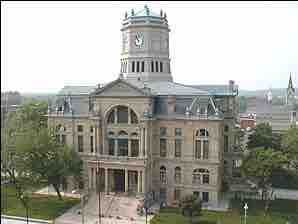
The first Butler County court building was a two-story structure housing a jail and courtroom which was erected in 1810 on the site of a former garrison building at Old Fort Hamilton.
In 1817, a brick, two-story courthouse was built on the public square on land which was donated by Israel Ludlow. A bell signaled the start of court, public occasions and emergencies.
In 1837 a portico and Corinthian columns were added, with a clock tower and cupola. That structure was demolished in 1885.
The present Butler County Courthouse was erected in 1889 at a cost of $305,000. The building was surmounted by a clock tower on which stood a statue of the Goddess of Justice, blindfolded, grasping her sword and holding aloft the scales of justice. There was a small dome on each of the four corners of the building. The interior is graced by red granite and marble, with prime oak, black walnut and cherry woodwork.
In 1912, three Hamilton firefighters died in a fire in the courthouse. The fire destroyed the tower, cupola and statue, all of which were replaced in 1914 by a larger clock tower and a massive dome which rose 225 feet above the street.
The courthouse also served as a temporary morgue when more than 200 people died in the flood of 1913. In 1926 the great dome was damaged by lightning and subsequently dismantled; however, the clock tower still remains.
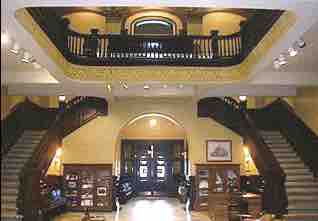
The double stairways from the second to the third floor of the courthouse are open, with a cut-out ceiling exposing the top floor of the building.

Red granite and marble columns and archways decorate the third floor of the Butler County Courthouse.

American flags hang around the top floor of the Butler County Courthouse, highlighting the structure's ornate ceiling.

The courtroom pictured above is still used today. Although modernizations have been made to the room, it still maintains historic value.
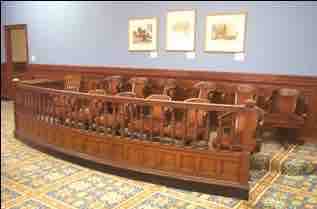
Pictured above is the jury area in the courtroom shown on the previous page.
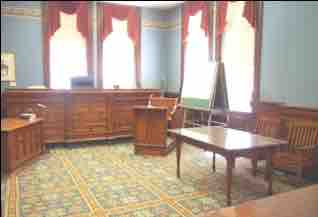
A closer look at the judge's bench located in one of the courthouse's courtrooms.
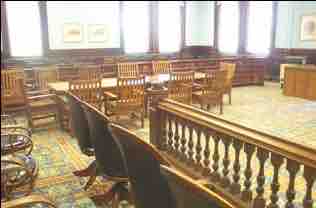
The courtroom pictured above is designated the courthouse's "historic courtroom." This courtroom will continue to be used for court proceedings and plans for refurbishment are included in the courthouse restoration effort.
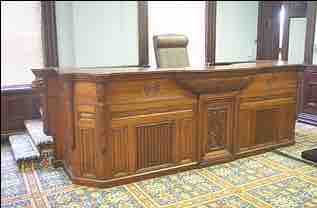
A detailed look at the judge's bench found in the "historic courtroom" shows the carved rams' heads on each front corner. The carvings match many others on the bailiff's bench and gallery railings. The bench was part of the original courtroom.

The jury chairs found in the "historic courtroom" are from the same time period in which the courthouse was originally built. Twelve chairs comprise the jury area.

